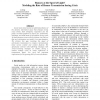Free Online Productivity Tools
i2Speak
i2Symbol
i2OCR
iTex2Img
iWeb2Print
iWeb2Shot
i2Type
iPdf2Split
iPdf2Merge
i2Bopomofo
i2Arabic
i2Style
i2Image
i2PDF
iLatex2Rtf
Sci2ools
HICSS
2016
IEEE
2016
IEEE
Rumors at the Speed of Light? Modeling the Rate of Rumor Transmission During Crisis
Social media have become an established feature of the dynamic information space that emerges during crisis events. Both emergency responders and the public use these platforms to search for, disseminate, challenge, and make sense of information during crises. In these situations rumors also proliferate, but just how fast such information can spread is an open question. We address this gap, modeling the speed of information transmission to compare retransmission times across content and context features. We specifically contrast rumor-affirming messages with rumor-correcting messages on Twitter during a notable hostage crisis to reveal differences in transmission speed. Our work has important implications for the growing field of crisis informatics.
Biometrics | HICSS 2016 |
| Added | 03 Apr 2016 |
| Updated | 03 Apr 2016 |
| Type | Journal |
| Year | 2016 |
| Where | HICSS |
| Authors | Li Zeng, Kate Starbird, Emma S. Spiro |
Comments (0)

